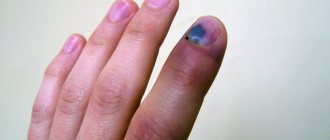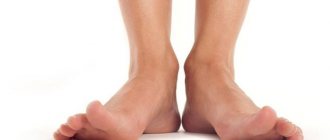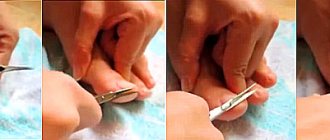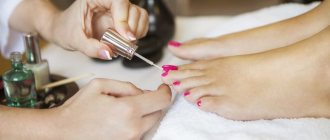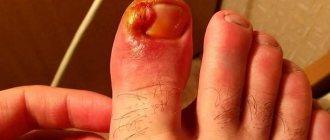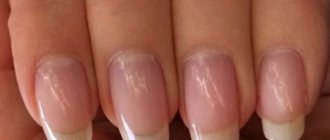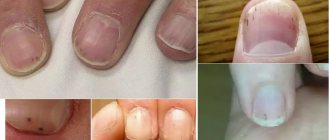Why the cuticle is inflamed: reasons
A damaged cuticle will no longer be able to prevent infection from penetrating under the nail plate and the finger underneath it for various reasons.
- Infection can occur due to various traumatic injuries, most often this occurs after a manicure, if proper hygiene measures and sterile processing of instruments have not been observed, or mechanical damage has been caused to the cuticle. Inflammation can occur on both fingers and toes during a pedicure.
- Some people have a childhood habit of biting their nails in nervous situations. Damage to the cuticle and saliva getting into the open wound can also lead to an abscess.
- Neglecting to take care of your nails is also a risk factor for cuticle inflammation. It grows, becomes thicker, cracks, and is more likely to be easily damaged, especially in people with dry skin. In winter, the risk of inflammation becomes even greater.
- Swelling and irritation can also occur in people with allergies or as a result of contact of exposed skin with various chemicals, for example, when working with household chemicals.
- The cuticle may also be damaged during some work, for example, in the garden.
- The most serious damage can be caused by infectious bacteria, such as fungi, which can get on it through poor hygiene in public places or through direct contact with a contaminated surface.
Important! Inflammation can be recognized by the following signs: redness in the area of the cuticle and finger around the nail, swelling, unpleasant painful sensations in close contact with the cuticle.
In such cases, it is very important to begin treatment immediately so that the inflammation does not develop into a more advanced form with purulent discharge. The sooner you start treatment, the less likely you are to get complications from inflammation.
Pain near the big toe nail treatment
It happens when it is simply impossible to put on dress shoes or just walk quickly due to severe pain localized on the toe near the nail. In some cases, such a symptom prevents people from simply walking or even sleeping.
In the best case, the pain may go away on its own within a week, and in the worst case, it can provoke the need for surgical intervention.
In this article we will look at why the big toe hurts near the nail, as well as how to get rid of this symptom.
Causes
There are many reasons for this condition. Some of them are far from harmless. In any case, if your big toe hurts near the nail, you should consult a doctor, since such a symptom can be caused by very serious reasons.
You should not self-medicate, as you can get inflammation that will require surgical intervention in the future. When the big toe hurts near the nail, it causes severe discomfort while wearing shoes.
So, let's look at the possible reasons for this pain:
- Nail injury.
- Hangnail.
- Ingrown nail.
- Systemic disorders and diseases.
- Local inflammatory process.
Now it’s worth taking a closer look at the reasons why your big toe hurts near the nail.
Nail injury
Regardless of the main cause of the injury, the process in the area around the nail will proceed the same way, that is, accompanied by severe pain. Let's consider the stages and consequences of an injury that causes pain in the nail on the big toe:
- A strong blow or other damage to the nail.
- Rupture of blood vessels, as well as disruption of the nerve endings near the nail.
- Formation of bruising, as well as disruption of the metabolic process.
- Changing the shade of the nail plate, as well as the area of skin nearby.
- Complete death.
- Growth of another nail plate.
If the injury was severe, the shade of the damaged area changes immediately, and pain will be felt constantly. In addition to the fact that the nail on the big toe hurts, swelling and redness also appear. If the swelling spreads to the foot, then there is a possibility of damage to the phalanx.
Treatment for bruise
In this case, if you have pain near your big toe, then a specialist should prescribe treatment that can help you get rid of the pain and also speed up the regeneration of the nail.
If the matrix under the nail plate is not protected, then areas nearby will also begin to cause serious discomfort.
When there is pain around the big toe, a specialist will prescribe bandages, painkillers, and anti-inflammatory drugs that will alleviate the condition.
Treatment of ingrown toenails
If your big toe is swollen and painful due to an ingrown toenail, then you can get rid of this ailment by treating the problem area with a laser beam. Also, very often nowadays, a similar problem is treated by exposure to radio waves. In the most advanced cases, complete removal of the damaged nail plate is required.
However, if there is pain near the big toe due to an ingrown toenail, you can cope with such a symptom yourself using traditional medicine recipes and conservative methods. First of all, you should change your shoes to more comfortable ones.
The use of antifungal and antibacterial drugs is mandatory. Feet should be kept clean. If you want to get a pedicure, it is better to seek help from a professional.
If you constantly follow these rules, then the likelihood of pathology forming around the fingernail will be minimized.
Hangnail formation
We continue to look at why the big toe hurts. The reason may lie in the formation of a hangnail. A small open wound, mechanical damage, as well as vitamin deficiency can cause this phenomenon.
When an infection gets under the skin, an inflammatory process begins near the nail plate on the finger, and an abscess forms.
In the most serious forms, the inflammatory process develops into various types of foot diseases.
Source: https://tikhvinskoe.ru/bolit-vozle-nogtja-bolshogo-palca-na-noge-lechenie/
Photo
Further in the photo you can see the inflammatory process of the cuticle near the nail plate.
Treatment
Do not rush to see a doctor immediately; in the initial stages, the cuticle can be cured on your own if the inflammation begins on one finger. If there is inflammation on several fingers at once, you should immediately contact a dermatologist, there is a high probability of infection with a fungus.
Attention! Inflammation in the skin occurs in such a way that to remove purulent discharge, it is enough to lightly press on the sore finger, and the pus will come out.
Before carrying out this procedure, you need to briefly steam your finger in a bath with a solution of potassium permanganate, which has a light pink color. After cleaning and disinfecting the wound, inflammation on the finger can be cured with both folk remedies and medications.
How to treat?
The following medications are recommended to be used:
- Vishnevsky ointment traditionally cures various inflammatory processes on the skin well. It is enough to apply it on a piece of cotton wool or a cotton pad, apply it to the inflamed area, and secure it with an adhesive plaster or bandage. It is optimal to treat the cuticle and finger with ointment before bedtime. Overnight, the ointment will be well absorbed into the skin and will help relieve pain and redness and draw out purulent discharge.
- Ichthyol ointment is used similarly to Vishnevsky ointment and has a similar treatment principle.
- When the abscess at the site of inflammation breaks through, the open wound must be treated with an antiseptic such as hydrogen peroxide or chlorhexidine to prevent the infection from spreading throughout the finger and then apply Miramistin or Levomekol ointment.
Folk remedies
Folk remedies include:
- The most affordable and effective remedy for relieving the symptoms of inflammation is aloe leaf. It needs to be cut lengthwise and a fresh cut applied to the sore side of the finger. A compress based on aloe juice will also help: soak a bandage with it and apply it to the sore spot. Aloe-based creams and oils are slightly less effective.
- You can use the old “grandfather’s recipe”, when part of the bandage is rubbed with damp soap (preferably laundry soap), then sprinkled with salt, after which the bandage is wrapped around the sore spot.
- Baths with infusions of medicinal antiseptic herbs also do a good job of treating inflammation.
A decoction is made from chamomile, oak bark, and calendula in a ratio of one to ten with water. To do this, you need to add the medicinal herb to water, boil it for five minutes, then remove it from the heat and let it brew for about half an hour. Then dip the sore finger into the resulting infusion for ten minutes. - Ointment based on flour and honey. Flour is added to honey until a kind of dough is formed. This piece is applied to the sore spot, wrapped in a bandage and kept for about twelve hours.
- Well, where would we be without plantain! It or sorrel leaves are crushed very finely and similarly applied to the inflammation for six hours.
- Various essential oils can be applied to the inflamed area of the finger about six times a day.
Pain in the big toe near the nail: possible causes, treatment methods
It happens when it is simply impossible to put on dress shoes or just walk quickly due to severe pain localized on the toe near the nail. In some cases, such a symptom prevents people from simply walking or even sleeping.
In the best case, the pain may go away on its own within a week, and in the worst case, it can provoke the need for surgical intervention.
In this article we will look at why the big toe hurts near the nail, as well as how to get rid of this symptom.
Hangnail treatment
Quite often, hangnails on the skin near the nails hurt due to trauma to the skin. At the initial stage, iodine and brilliant green can be used for treatment.
But if an abscess has formed, then special ointments are used, for example, “Levosin” or “Levomekol”. After treatment, the finger heals in just a couple of days.
If a tumor appears in the nail area, and you also feel severe pain that does not go away even after treatment, you should consult a doctor.
To avoid possible inflammation from hangnails on the skin, the following rules must be followed:
- Use only sterile pedicure accessories.
- Always have antiseptic preparations on hand.
- The place where the hangnail forms must be sealed with an antiseptic plaster.
- The skin of the feet should be moisturized and nourished to prevent the appearance of hangnails around the nails.
If purulent contents form or are released, you should seek help from a dermatologist, because this liquid is a sign of serious diseases.
Systemic diseases
If your leg is swollen and your big toe hurts, then the reason may lie in the presence of some serious disease in the body. A similar symptom can occur with the following ailments:
- Arthritis.
- Arthrosis.
- Disruption of the cardiovascular system.
If the big toe hurts on the side, on top or in another place, then it may also turn blue or turn white. Such diseases bring great inconvenience to the patient. In addition, diabetes mellitus is a common cause of this symptom. The disease, in the form of additional symptoms, causes cracks, burning, and pain in the feet.
If your big toe bone hurts, what should you do? In a situation where this happened due to a systemic disease, the symptom can only be eliminated if the main disease is cured. And this is carried out only after a complete examination by a doctor.
Treatment of local inflammation
If treatment is not started in time, the inflammatory process can affect the joints and bones of the toe. In this case, the disease will be difficult to cure, and the patient will feel severe pain in the limbs. Therapy consists of the use of antibiotics and antibacterial medications.
In addition, for external treatment of problem areas, the specialist prescribes gels and ointments that prevent the development of infection. In the most advanced cases, treatment requires surgery to remove the abscess.
This is necessary in situations where the toe is very red and the pain is unbearable.
Before starting the main treatment, the doctor must identify the main cause, relieve pain around the fingernails, and also eliminate the main source of its manifestation.
Other reasons
In some cases, pain in the fingers near the nails is caused by specific causes. This includes skin cracks, peeling, where when an infection occurs, an inflammatory process appears, accompanied by redness and severe pain. Even if the infection does not get under the skin, this process causes very unpleasant sensations.
Quite often, an abscess on the toe is the result of a simple splinter. Even a small splinter that gets under the nail will not hurt until the inflammatory process begins. To avoid this, you should remove the splinter and treat the area around the finger with an anti-inflammatory agent.
The inflammatory process, pain in the nail area, as well as on the toes, is also caused by a fungus, which provokes injuries on the skin, around the nails, as well as on the entire surface of the fingers. The toes look damaged and ugly in appearance, especially their nails.
Self-medication in this case is inappropriate. If you have the first suspicion of a fungal infection of the skin, you should consult a doctor. Mycosis is a rather insidious disease, and if it occurs in an advanced form, it will be very difficult to get rid of it.
In addition, the fungus is dangerous to others.
Folk recipes
If your finger near the toenail festers, then you can use procedures, home remedies that you can prepare yourself. The most effective of them are the following:
- Foot baths. To prepare such a bath, you will need baking soda and iodine tincture. The fact is that salty components help get rid of the inflammatory process, and iodine effectively copes with microbes. To prepare one bath you will need 1 liter of boiled warm water, to which one tablespoon of soda is added, as well as a few drops of iodine.
- Compress. One leaf of plantain or coltsfoot plant needs to be kneaded, and then a compress is made from the resulting pulp on the area around the finger. It must be kept at the site of inflammation for about 10 hours. That is why it is best to do this procedure at night.
- Vegetable compress. To prepare this home remedy you will need a mixture of raw onions, beets, carrots. All vegetables are grated on a fine grater, and a small amount of aloe plant juice is added. All ingredients are mixed, after which the resulting mixture is applied to the damaged area and secured with a bandage on top. The compress remains on the problem area for several hours.
- A fairly effective remedy is a cake made from boiled potatoes using a small amount of honey.
- Baked onions. To do this, the vegetable is divided into two identical slices and baked in the oven for 15-20 minutes. After this, the onion is applied as a compress to the affected area. Please note that the vegetable should only be used warm.
- Tincture based on Japanese Sophora. It is best to purchase a ready-made product at a pharmacy, and use it according to the instructions included.
In any case, before treating an abscess near the fingernail, it is necessary to objectively assess the development of the process. If suppuration in this area is very widespread, then it is better not to waste time and immediately seek help from a doctor.
How to help the body?
In most cases, the reason why pain occurs on the toe near the nail indicates a decrease in the body's immune system. To strengthen your body's defenses, you need to:
- Eat well. The diet should be such that it contains a biologically justified combination of fats, proteins and carbohydrates.
- Carry out vitamin therapy and mineral therapy. This suggests that the diet should be dominated by a sufficient amount of foods high in vitamins and minerals necessary for the body.
- It is advisable to get rid of bad habits, in particular, smoking, drinking alcohol, and visiting fast food establishments.
- To live an active lifestyle.
- Maintain a rest and work schedule.
Prevention of inflammatory processes on the hand near the nail plate
To prevent such a minor, but very unpleasant inflammation of the cuticle and finger, it is enough to follow simple preventive measures:
- Constant adherence to hygiene rules. Hangnails on and around the nails should not be picked off or bitten off. If the cuticle is still damaged, do not forget to treat the wound with an antiseptic.
- If you have problematic, dry skin or have worked with household chemicals, do not forget to take care of your skin. Use softening creams.
- When performing various tasks around the house or in the garden, protect your hands with special household gloves.
- Get your manicure done only by professional nail technicians who process the tool in a timely manner. If you take care of your nails yourself, also do not forget to sterilize all instruments in a timely manner, do not rely on chance, consult with the masters on how they sterilize their instruments.
Reference. In order for your cuticle to always be healthy and well-groomed, when performing a manicure you need to remove not all of it, but only dead cells.
An overgrown cuticle can cause many problems for your beauty. It changes the shape of the nails and stripes appear on the nails. There are several ways to remove dead cuticles.
Classic way
Here the cuticle is trimmed with manicure tools - various scissors and tweezers:
- During this procedure, the hands are treated with a disinfectant, then the nails are shaped. This must be done before soaking, so as not to damage the nail when filing and to avoid delamination.
- Then a bath with warm water is prepared. You can add medicinal salt, herbal decoction or softening gel to the water. For fragrance, add a few drops of your favorite aromatic essential oils. You need to hold your hands in this bath for about seven minutes.
- After that, do not forget to remove the remaining polish or gel polish from the nails.
- After which the cuticle is removed with tweezers or scissors. This is a very important part of the procedure, so you should not save on tools by buying the lowest quality and cheapest; preference should be given to stainless steel tools with manual sharpening of the cutting surface.
- Next, very carefully push the cuticle with a pusher tool from the edge of the nail to its middle.
- We use a special file to clean the pterygium (this is what manicurists call the barely visible layer of cuticle on the nail plate). Be careful not to scratch your nail when performing these operations.
- Then trim off the keratinized pieces of skin around the nail, try to remove the cuticle in one piece, then you won’t get hangnails.
- At the end of the procedure, apply nail care cream or oil to the cuticles.
The undoubted advantage of this method is the ability to get well-groomed nails in the shortest possible time. The disadvantages are that more cuticles are removed than necessary, which can increase the risk of infection, and after the procedure itself, the cuticle grows more quickly, becomes tougher and creates problems with further removal.
The following video shows all the stages of a classic manicure:
No trim manicure
In general, it is similar to the classic method of removing cuticles, with the only difference that instead of tweezers or scissors, chemicals based on alkali or acids are used to remove it. They are also called “keratolics”. Keratolytics help soften the cuticle, after which it is moved using a special “orange stick”.
Since the fingers are not first steamed in a bath,
a trimless manicure can also be called “dry”. This manicure ends in the same way as a classic one, by applying care products to the nail plate and finger.
There are many more advantages to this method, the safety for the health of the finger is much higher, the skin is not injured and, most importantly, only dead parts of the cuticle are removed!
Important! However, it is difficult to immediately switch to a trimless manicure from a classic one; several intermediate procedures will be required to prepare the cuticle.
The video below shows how an unedged manicure is done:
Brazilian
It is also a branch of the classic manicure with the difference that a nail file is used instead of cutting tweezers or scissors. And to moisturize the skin, use special moistened gloves soaked in a fortified composition. These gloves are used to massage the fingers, then a softening cream is rubbed in with them, and then the cuticle is pushed back with a special stick and treated with a nail file.
This method is good because it eliminates the risk of infection, the skin is not injured, and thanks to the fortified impregnation of the gloves, the skin is saturated with useful minerals and vitamins. They mainly remove keratinized areas of the cuticle and skin, preserving the living ones. Well, during the procedure it smells pleasantly of herbs and fruits. And you don’t have to use an expensive tool.
Among the disadvantages is that such a Brazilian manicure will not help in particularly difficult situations and neglect, and to carry it out you need to buy special kits.
All stages of Brazilian manicure can be seen in the video:
Hardware
An increasingly popular type of nail and cuticle care.
The method is high-tech, which does not require pre-softening and preparing the skin; only dead cells are removed, while living ones continue to protect the nail. However, this manicure is inconvenient because it cannot be done at home; it is done only in special nail salons.
All the nuances of this procedure are shown in the video:
Solar
Attention! One of the most fashionable and latest innovations. This method is very useful for the cuticle itself, and it can be done at home.
For this purpose, a special preparation is purchased, which contains various salts and oils from the Dead Sea and its surrounding areas. The role of peeling is performed by medicinal salts, and the oil prepares and moisturizes the skin.
- To carry out a solar manicure, first the hands are disinfected, then the drug is applied and a massage is performed with dry hands and then with wet ones. The salts of the drug, under the influence of moisture, penetrate deep into the skin, and a soft peeling is obtained. During this procedure, dead skin cells and cuticles are exfoliated, the pores on the skin open wider, and the oil of the drug penetrates very deeply into the skin.
- Then, for the “sauna effect,” a plastic bag or plastic gloves are put on your hands.
- After about twenty minutes they are removed and the hands are massaged again. In this case, a cream with oils from the Dead Sea is also used. Due to this combined and healing effect, the skin of the fingers is moisturized very deeply, it turns out smooth and very elastic.
Beautiful, well-groomed and healthy fingers and nails say a lot about their owner. Don’t forget to follow simple rules of prevention, and then soft, smooth and healthy fingers will thank you and save you from further hassle with treating inflammation. Remember that even the best manicurist will not be able to make your fingers attractive if you do not take care of your cuticles yourself.
Causes
A common cause of purulent inflammation is trauma to the periungual tissues, which can occur as a result of a carelessly performed pedicure procedure, when splinters and microtraumas appear.
Violation of the upper layer of skin (epidermis) serves as an “entry gate” for the penetration of an infectious pathogen.
In turn, inflammation of the toe of septic origin can be caused by:
- fungus of the Candida type, which is a type of opportunistic pathogen that lives on the skin;
- pyogenic cocci that produce pus;
- ulcerative paronychia, which results in ulcerations on the periungual fold.
Parasitic fungi, as well as staphylococci and streptococci, live everywhere, including on the skin of human feet. In the absence of damage to the epidermis, good immunity and the absence of severe chronic diseases, the microflora does not pose a danger to humans.
When deviations occur, pathogenic microorganisms can lead to suppuration.
Provoking factors that cause the formation of an abscess on the finger include:
- the appearance of scratches, cuts, abrasions on the skin near the nail;
- exposure to chemicals;
- ingrown nail;
- frequent overheating of the feet.
Endocrine pathologies – diabetes mellitus, dysfunction of the thyroid gland – increase the incidence of abscess on the finger. Improper metabolic reactions, hormonal imbalances, and chronic diseases of internal organs contribute to a decrease in the body's defenses.
Wearing low-quality shoes, incorrectly selected for the size or season, and poor personal hygiene lead to the development of inflammation of the big toe.
